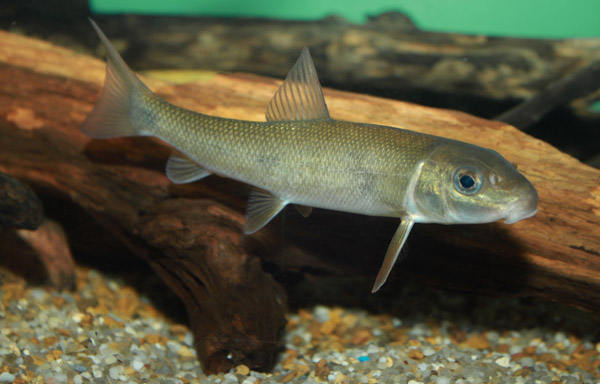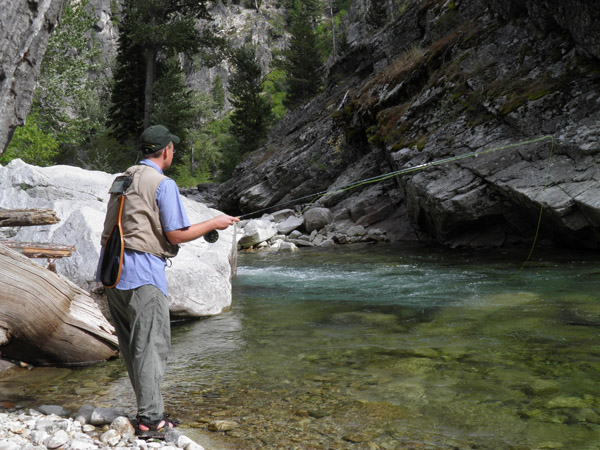Almost everything you’ve ever heard about suckers is probably wrong.
Not just wrong. Flat-out crazy wrong.
Yeah, I’ve heard all the “facts” about suckers, too. Many times.
They’re dirty. Non-native. A sign of polluted water. Garbage eaters. Egg eaters. Not to mention horrifically ugly.
They compete with native fish, like trout and bass. There are too many. They’re overtaking the waters.
The best thing to do? Catch ‘em and throw ‘em on the bank. You’ll be doing the stream a favor.
No, no, no. Hell no.
I understand the depth of the sucker’s image problem. I do. Even the name – sucker! – suggests the PR challenges that lie ahead.
But I don’t want to just dispel sucker myths here. That’s not enough.
No: I’m suggesting that suckers would serve us well as a new symbol for rethinking fisheries management, water quality, fishing ethics and freshwater conservation.
This isn’t hyberbole. I’m serious. Move over trout. I have seen the future, and it’s for suckers.
Myth Busters: Sucker Edition

On the President’s Day holiday, I stood on a foot bridge overlooking crystal-clear springs, fishing for largescale suckers.
It was part of my New Year’s resolution to expand my angling horizons – to gain a greater appreciation for other species beyond the usual rainbow and brown trout. I’m a naturalist with a fly rod. Fishing is my means of exploring the underwater realm.
It was a beautiful day to be in the Thousand Springs region of Idaho, enjoying springs protected by The Nature Conservancy. The suckers were highly visible; large fish congregated by the dozens.
But my sucker reverie was soon interrupted. Within minutes two different people approached me to share their sucker knowledge. Like they had a compulsion to do so.
“We call them pike minnows, or carp. They’re invasive.”
Three strikes here.
This highlights a big problem with fish conservation: Most people don’t really know fish. Anglers included.
Aside from some common game species, most are happy to lump everything else together. Like my new friend.
His short comment was filled with error. To boot: Suckers are not pike minnows, native fish with an image problem of their own. (They’re blamed for declining salmon runs, never mind dams).
They definitely aren’t carp, which actually are non-native species. Suckers are not invasive: 78 of the some 80 species in the sucker family, Catostomidae, are found exclusively in North America.

I barely had time to respond when another visitor approached.
“Fishing for suckers, huh? Well, I don’t think you’re going to catch them here. The water’s too clean. They only live in polluted streams. They eat garbage. That’s what I heard.”
OK, let’s think about this carefully for a second:
The. Water. Is. Too. Clean.
Here we must confront the most common of sucker myths: that this is a fish so vile it actually needs our pollution, our sediment, our trash.
And it’s totally, completely, 100 percent wrong. If you think about it, it makes no sense. No fish needs dirty water, after all – not even carp.

For many sucker species, it’s quite the opposite. They need the purest, cleanest water. They need healthy river habitats. They need free-flowing stream so they can make their spring spawning run – just like other, more celebrated migratory fish.
The sucker, ultimately, is the perfect symbol for healthy rivers and fisheries. So why do the myths persist? The answer lies in angling culture and its own cherished mythology.
The Fishy Truth About Recreational Fishing

Anglers are fond of their conservation achievements, and rightly so. They point out that they are often the people who know rivers best, and thus are uniquely positioned to defend them. See the fight to protect Bristol Bay for a dramatic illustration of this.
The literature of angling is heavily populated with certain themes: respect for fish, for rivers, for nature.
Sometimes trout fishing can be portrayed as an almost transcendental activity. No clear line between religion and fly fishing and all that.
Many anglers do genuinely love native fish and natural habitats, too. Nonetheless, closer examination of angling history reveals murkier waters.
Recreational anglers have often been the most enthusiastic purveyors of non-native species, spreading the same usual suspects – rainbow and brown trout, largemouth bass, walleye – hither and yon, with no regard for local ecology.
Truth be told, some anglers would rather follow a hatchery truck filled with domestic trout than learn stream ecology.
But more to the point here, there is a long tradition of creating fish villains: any species perceived to feed on precious trout and bass.
Rather than blame dams, pollution and habitat destruction, some anglers seek scapegoats. Like suckers. They accuse suckers of suctioning up trout eggs off the stream bottom and pushing out “beneficial” fish.
And thus, killing suckers becomes moral imperative.
“A Good Slice to the Belly”

Sadly, this viewpoint still persists. Consider the comments on an Idaho fishing forum concerning what you should do if you catch a sucker:
“Kill and through [sic] back.”
“If you catch them while trying to catch trout of coarse [sic] they are in direct competition with the trout. They eat the same thing. There is only so much food and if the suckers are eating it. Less food for the trout.”
“yeah a good slice to the belly or a few puncture wounds to pop there [sic] air bladder works great for a catch and release on those suckers and carp!!!!”
“I have a close friend who is a biologist… He simply slices open the belly and returns them back to the water. His theory is they will be food for something. And wont [sic] be eating the fish we have come there to catch. Side note….Look at Big Springs in Island Park. Huge suckers in there now…Makes me sick…”
Comments like this make me sick, and not because of the massacre of the English language.
Don’t pass this off as just the online rantings of vigilante anglers. In some lakes, tiger muskies — a hatchery-produced hybrid — are introduced specifically to control suckers. The reason? So hatchery trout don’t have competition.
It suggests that Douglas M. Thompson is correct in his book-length critique of American fishing tradition, The Quest for the Golden Trout: anglers often view their history and conservation tradition through rose-colored glasses.
It doesn’t have to be this way.
Freshwater Pandas???

At this point, some readers will invariably identify me, as an avid angler, as part of the problem.
Some think we should just leave wildlife alone, all the time — a comment I receive a lot when writing about interacting with wildlife.
Fair enough. Still, even if you never go fishing, you’re (pardon the pun) not off the hook.
The fishing community has often been antagonistic about suckers, but the non-angling community hasn’t been much better.
There is truth in the idea that protecting something starts with knowing and loving it. We need people defending rivers and freshwater habitats.
Have non-anglers really stood up for suckers and other native fish? Not really.
Look at the materials produced by environmental organizations. How often do you see a sucker, despite the 80 species swimming in clean, wild waters? On the other hand, these groups celebrate trout streams all the time, The Nature Conservancy not excluded.
A general, all-encompassing love of biodiversity is a lofty goal, but the reality is most people gravitate to a few charismatic species. Suckers are not freshwater pandas. But maybe they should be.
I propose that suckers would make good conservation icons: protect their habitat, and you’ve protected a lot of other native river species. Understand their needs, and you’ve gone a long way to understanding the complexity of freshwater ecosystems.
To get there, I believe, we need dedicated conservationists who know and love all river creatures, including suckers.
Am I aiming too high here?
Don’t despair: help is on the way.
The Rough Fish Brigade

There have always been anglers and non-anglers who have seen the bigger picture: who understand fish and habitats and the need for clean rivers.
More and more trout anglers value native fish, and have been working to reintroduce and restore trout species and subspecies across their range. Trout Unlimited is leading the charge.
That’s a great trend. But an often unheralded group of angler-conservationists is taking it farther: celebrating all native fish species.
Calling themselves rough fishers, they go crazy for suckers and species derided by others as “trash fish.” They rightly recognize them as interesting angling quarry, true, but also recognize that these fish need conservation attention.
They rail against misguided fishery policy that treats these species as competitors to “game” fish. They encourage young anglers to respect and protect all fish species.
Web sites like Rough Fish and Ben Cantrell’s Fish Species Blog are on the vanguard of just what intelligent angling can be – an ethic that celebrates freshwater biodiversity in all its forms.
And this ethic isn’t just for anglers. Enthusiastic, self-described “fish nerds” look to excite students and others about the weird and wild world of freshwater fish. They see fish as exciting creatures in their own right, not just as quarry.
Exhibit A: Solomon David, a post-doctoral researcher with the Shedd Aquarium. David practically bursts with enthusiasm as he spreads the word on native fish through videos, blogs, tweets and fish puns.
He specializes in gar, primitive fish similarly convicted of crimes they didn’t commit.
But his ethos works for all freshwater species. He is igniting the interest in kids by understanding a vital fact. Fish like suckers and gar are the kinds of wild critters that inherently capture our interest. We have to be taught to revile them, just as we have to be taught to revere trout and bass.
Our opinions on fish are cultural artifacts, not based on any scientific reality.
Take off the blinders, and we see that suckers and gar as the freakishly cool fish they really are. We appreciate them as fascinating wildlife, worthy of our attention and respect.
And then: we begin to realize that we have been falling for tired myth and fishy prejudice for far too long. That we have too easily ignored our rivers and their full diversity of critters. We have met the real sucker in this story, and it is us.




Great article! The issues you raise sound very similar to an ongoing dispute in eastern Maine where supposed sportsman (guides specializing in smallmouth bass) have lobbied extensively to close fish passages allowing native river herring to access spawning waters because they think the herring somehow compete with the invasive smallmouth bass. Scary thing is they have had some success in this misguided effort.
Hopefully a new generation of anglers can be taught to think beyond the traditional “gamefish” species and better understand how natural ecosystems are supposed to work!
Great article, the only critisism I have is that you make a bit of a generalization that all suckers are native. I clearly see your intention to dispel the rumors that all suckers are non-native to North America, but suckers can become problematic non-native species outside of their native range. for instance, the white sucker is an invasive species in the Colorado River Basin, where it competes and hybridizes with native suckers such as the flannelmouth and bluehead. Suckers are often moved outside of their native range in bait buckets.
All in all a great article though. I work with federally endangered fish in the Colorado River, and I constantly hear complaints about how the government is “wasting money on suckers and chubs” instead of stocking bass and pike. I am constantly tring to come up with a quick and compelling argument that the typical warm water angler would listen to.
Mike (and everyone), thanks for the great comments. You raise a good point. Of course, a lot of fish have been moved around — including “non-game” species. I was trying to address the idea that suckers are all non-native. The largescale suckers mentioned in the story are definitely native where I was fishing. On a similar note, I have found many anglers automatically assume that all trout are native — even though that is often not the case.
Mike – Used to live in Colorado I’m well aware of the negative popular opinion out there towards native fish. Just know there are a number of us around who appreciate the efforts to restore those species.
Excellent article! With more education on the issues hopefully the public, including anglers, will begin to care about native fisheries. And with pressure from the public hopefully our state and federal wildlife agencies will halt some of the insane fisheries management practices that damage our native fisheries.
Yay !!! Good article. White suckers are a keystone native fish species in New England and they need fish passage at dams. At spawning time in April the males are as brightly colored as brook trout.
Great article! I’m the coordinator for the Desert Fish Habitat Partnership and we fund on-the-ground habitat restoration projects to conserve 179 native desert fishes in the West, suckers included! Please check out our Facebook page for more information on our partnership. https://www.facebook.com/pages/Desert-Fish-Habitat-Partnership/193053497376208?ref=hl
U need to report theses peoples comments to your DNR or MNR.
Very sad but unfortunately very true . I enjoy catching the “non main stream ” fish as much as the “main stream ” fish. Bowfin are another primordial survivor that are native fish unappreciated by the masses .
Great article. One comment though. When doing some lake trout spawning surveys in northern Ontario Canada, we actually found several white suckers stomachs loaded with lake trout eggs!
No doubt they do Matt, though not to the extent some claim. All fish eat eggs – I’ve gutted many, many trout stuffed full of sucker eggs in the spring. Perch and sunfish are also major egg eaters. I am quite sure other species benefit more from eating Sucker eggs (as well as suckers through adulthood) than the impact from having their eggs eaten
Michael, that is really cool!
Very nice article. If you think they are good for fishing, you should snorkel with them! Incredible behaviours. In certain places I have seen bass specifically following a hogsucker… as the hogsucker is sifting the substrate he occasionally disturbs a crayfish or other “too large for a hogsucker” item. The bass rushes in and grabs the item and then hangs back behind the hogsucker waiting for the next item. These bass are feeding behind the hogsuckers and will even defend “their” sucker from other bass.
Cool … scaley science … even white fish get a bad rap among some. Never disliked succors and have caught them many times incidentally and released them 98% of the time. Have to admit to killing a few along the way to make into cut bait for big trout back in my college meat fishing days 🙂 Thanks for another eye opener Matt.
And we might mention they are also highly edible. As a lad growing up in southern Minnesota we often went fishing and whatever we caught we took home for dinner, including suckers and carp.
Great stuff!
Wow, there should be more like this out there.
I cross the Atlantic every year, to spend time with my great friends, chasing and learning more about all of the fascinating, beautiful and varied American native fishes (that bigmouth buffalo spot looks familiar).
There’s such a wealth of beautiful and interesting species over there, and so very few people know or even care about it. I remember very well, the very first time I visited the US, how perplexed I was that there was no information at all about (or love for) the roundtail chubs and sonora suckers my buddy and I were chasing in Arizona. I just couldn’t understand it.
The good news is that interest and understanding is growing. And articles like this can only help!
P.S. You’re a brave man for delving into the dread comment section! The comments made me sad, but all the [sic]s made me laugh.
Right on! As a sucker/gar nerd and a fisherman, I’m always glad to read things like this–it helps keep my optimism intact.
I hope you’ll keep this sort of thing coming. The roughfishing “movement” is gaining traction. As people learn, attitudes change. After all, most of the people swooning for trout, bass and walleyes only do so because they’ve had no opportunity to know any different, and the vast majority of them have zero vested interest in maintaining the status quo. It won’t happen quickly, but I do foresee a time when the majority attitude among anglers is more in line with the facts of nature, biology, biodiversity, etc.
You might like some posts I wrote about the crimes of rough fish:
http://moxostoma.com/suckers-eels-vermin/
http://moxostoma.com/cowardly-pike-holy-trout/
If you’re ever in Illinois in summer, let’s go catch some gar.
Olaf